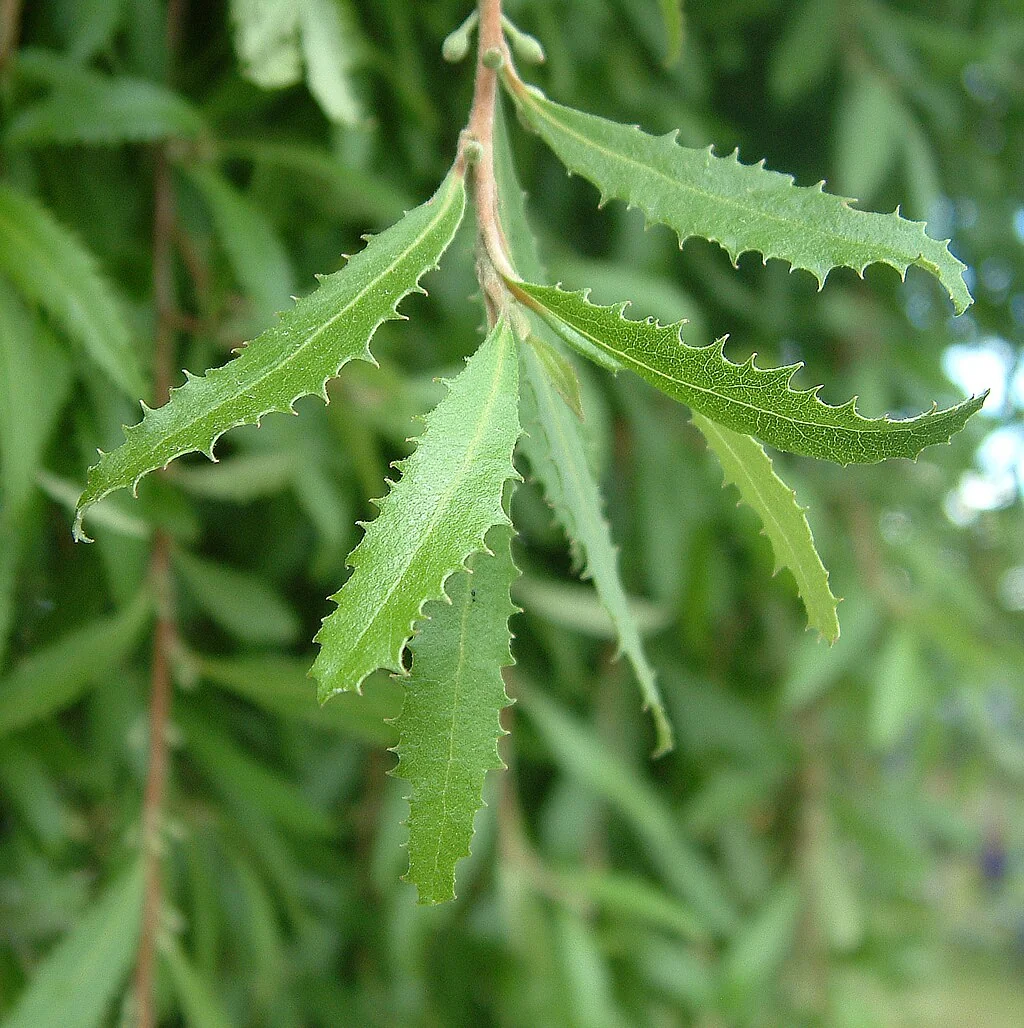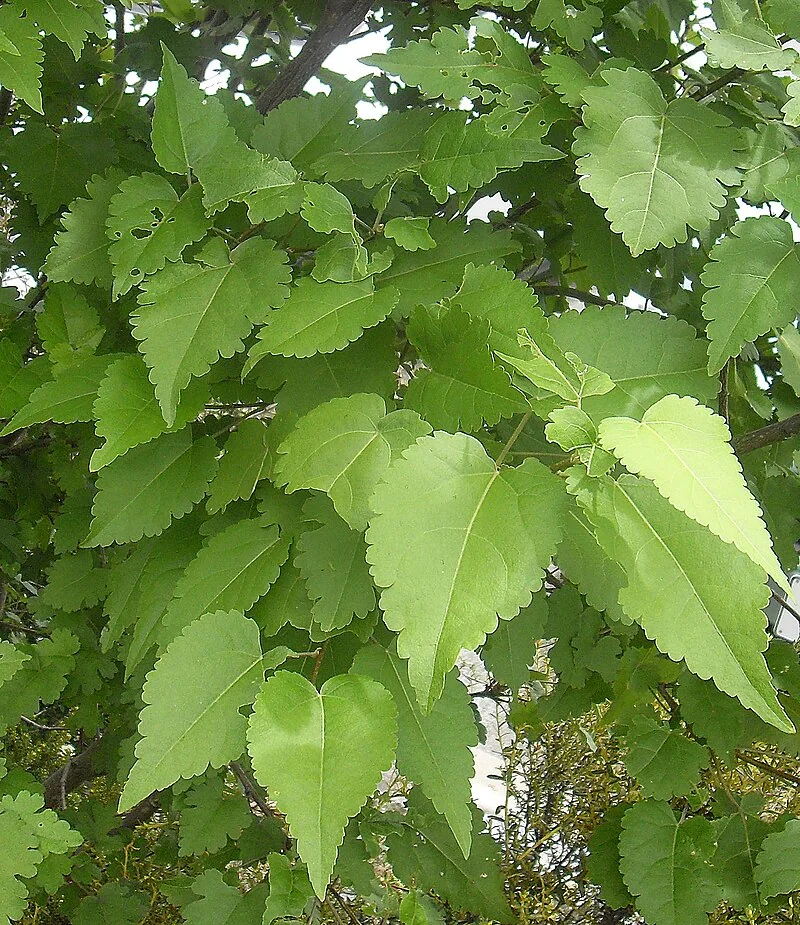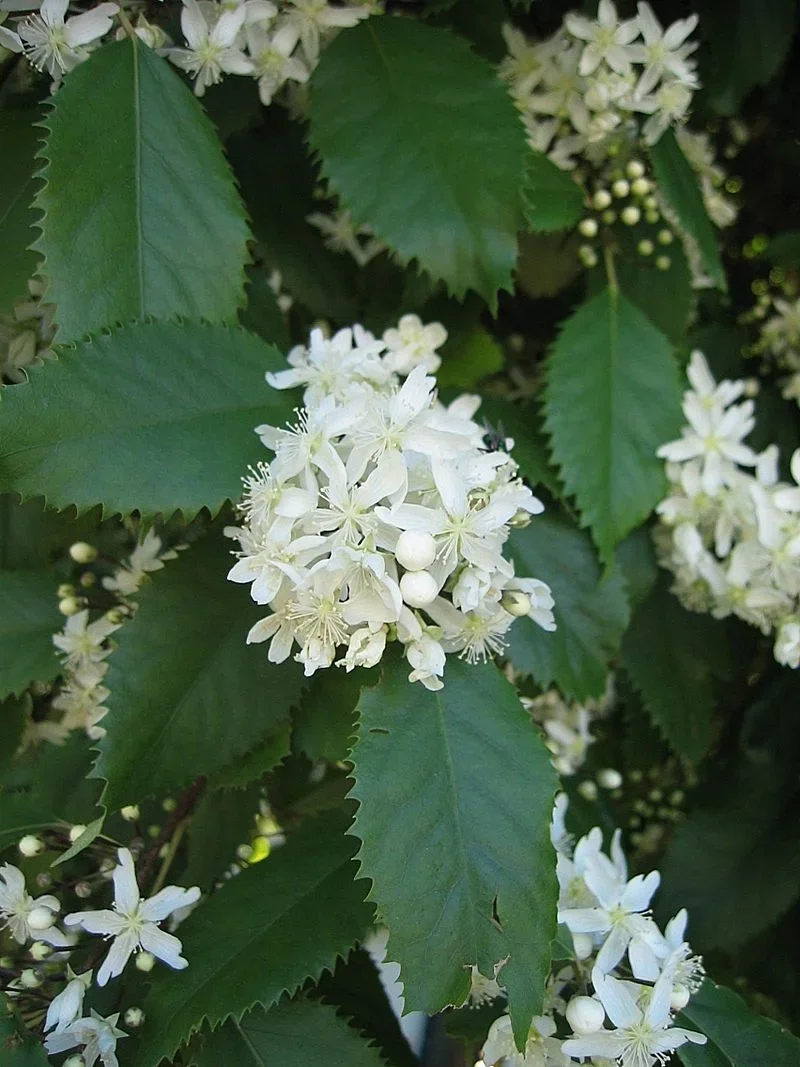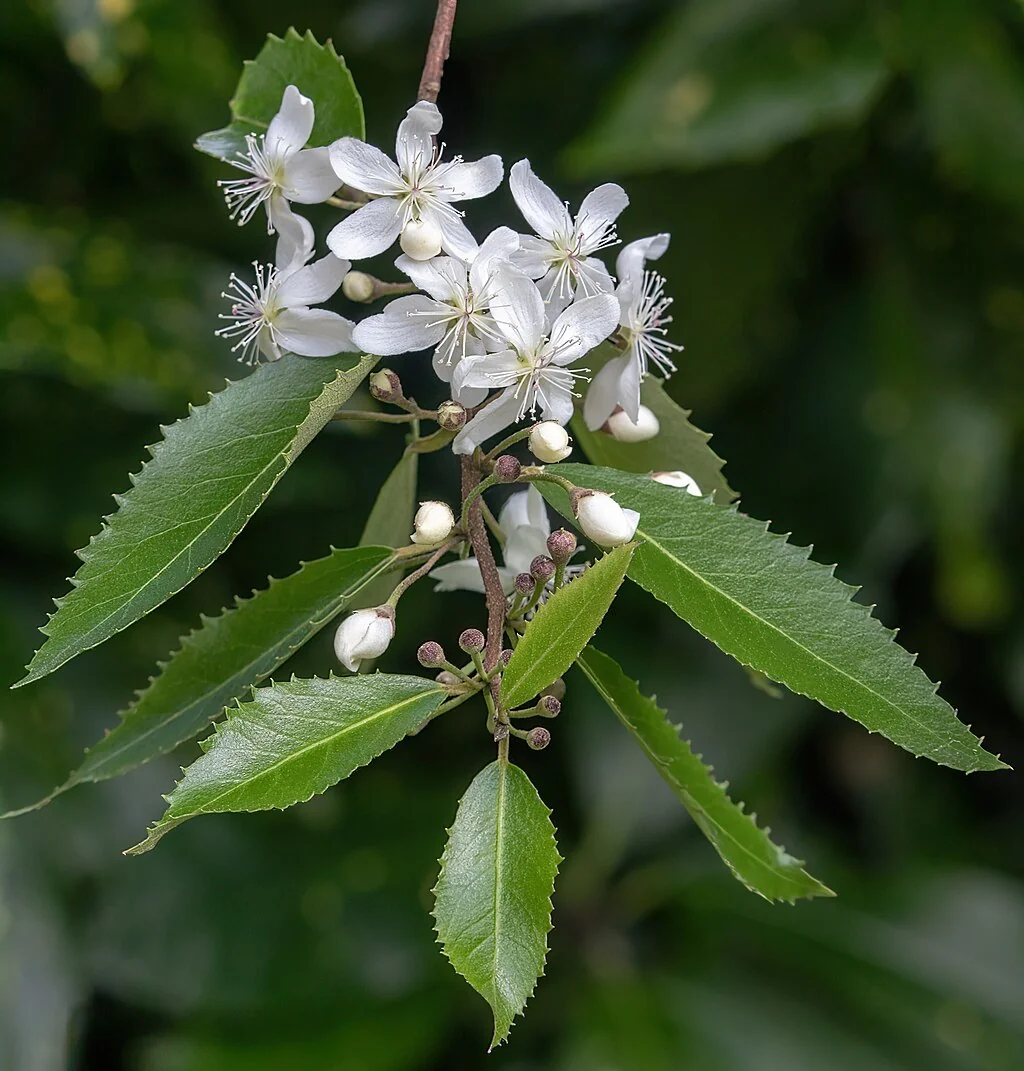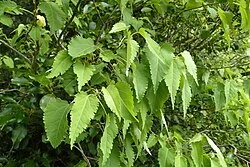
Mountain Lacebark
Hoheria lyallii
Mountain Lacebark ( Hoheria lyallii ) is a spectacular deciduous native tree renowned for its profuse white star-shaped flowers and stunning golden autumn foliage. Māori Mountain Lacebark's rapid growth, tolerance of harsh conditions, and exceptional ornamental value make it an outstanding choice for larger gardens and restoration projects seeking authentic New Zealand flora.

Plant Description
Hoheria lyallii (mountain lacebark) forms a small tree with elegant, serrate leaves and profuse white blossom; suited to cooler climates and high country gardens.
Quick Facts
| Scientific Name | Hoheria Lyallii |
|---|---|
| Common Name | Mountain lacebark, New Zealand lacebark |
| Plant Type | Deciduous tree |
| Height | Up to 8 m |
| Leaves | Thin, hairy, elliptic to deltoid, 33-156 x 22-89 mm, with uneven blunt teeth |
| Flowers | White, cup-shaped, 15.7-20.0 x 11.6-15.0 mm, 5 (sometimes 6) petals (summer) |
| Fruit | Dry, narrowly-winged fruit |
| Habitat | Drier mountain areas of the South Island of New Zealand |
| Spread | 4-6 m wide, open spreading crown |
| Water Needs | Moderate - drought tolerant once established |
| Light | Full sun to partial shade |
| Frost Tolerance | Very hardy - tolerates temperatures to -15°C |
| Salt Tolerance | Moderate - can handle some coastal exposure |
| Growth Rate | Fast - reaches mature size in 10-15 years |
| Lifespan | Long-lived deciduous tree (50+ years) |
| Hardiness | Hardy, drought-tolerant, withstands temperatures down to -15°C |
Climate Best Suited to
Mountain Lacebark thrives in cool temperate climates that closely mirror its natural mountainous habitat throughout New Zealand's South Island. This hardy deciduous species demonstrates exceptional frost tolerance, withstanding temperatures down to -15°C without significant damage, making it suitable for inland areas that experience harsh winter conditions. The species performs best in regions with reliable annual rainfall and moderate summer temperatures, preferring locations that avoid prolonged hot, dry periods or extreme temperature fluctuations. Cool nights and moderate daytime temperatures during the growing season encourage optimal flowering performance, with the most spectacular blooms occurring in areas that experience distinct seasonal temperature variations. Mountain Lacebark requires shelter from strong, drying winds, particularly hot northwestern winds that can stress the plant and reduce flowering quality. Consistent soil moisture throughout the growing season is preferred, though established plants can tolerate moderate drought conditions once their extensive root systems are fully developed. Regional suitability extends across most of New Zealand's major centers, with particularly strong performance in areas that experience winter chill requirements essential for proper dormancy and subsequent spring flowering displays.
Regional Suitability
| City | Climate Suitability |
|---|---|
| Whangārei | Ideal |
| Auckland | Ideal |
| Hamilton | Ideal |
| Tauranga | Ideal |
| Rotorua | Ideal |
| Gisborne | Ideal |
| New Plymouth | Ideal |
| Napier | Ideal |
| Whanganui | Ideal |
| Palmerston North | Ideal |
| Wellington | Ideal |
| Nelson | Ideal |
| Christchurch | Ideal |
| Dunedin | Ideal |
| Invercargill | Ideal |
Natural Habitat
Mountain Lacebark occupies a distinctive ecological niche in the subalpine and montane forest margins across New Zealand's South Island, where it forms a crucial component of the transition zone between lowland and alpine ecosystems. The species naturally occurs in river flats, valley floors, and forest edges at elevations typically ranging from 300 to 1200 meters, particularly in areas that receive reliable moisture from mountain precipitation patterns. These habitats are characterized by well-drained, fertile soils derived from alluvial deposits and weathered mountain rock, providing the nutrient-rich conditions that support the tree's vigorous growth and abundant flowering. Mountain Lacebark thrives in locations that experience moderate temperatures with distinct seasonal variations, including cold winters that fulfill its deciduous dormancy requirements and warm summers that promote optimal photosynthesis and flowering. The natural distribution encompasses major mountain ranges including the Canterbury high country, Marlborough ranges, and isolated populations in Nelson province, where the species contributes significantly to biodiversity and ecosystem stability through its role as both shelter provider and pollinator resource.
Conservation Status
Current Threats and Protection
Mountain Lacebark ( Hoheria lyallii ) maintains a conservation status of "Not Threatened" under New Zealand's threat classification system. This stable classification reflects the species' healthy population numbers and distribution across suitable habitat in the South Island's mountain regions, particularly in Canterbury, Marlborough, and isolated populations in Nelson.
The species demonstrates good resilience within its preferred mountainous habitat, naturally occurring in upper forest margins and subalpine zones where it forms part of the ecological transition between forest and alpine environments. While not currently at risk, Mountain Lacebark benefits from ongoing habitat protection in montane and subalpine areas, particularly as climate change may affect its preferred cool, dry conditions.
In cultivation, the species has proven adaptable and contributes to conservation through ex-situ preservation in botanical gardens and private collections. Its popularity in horticulture helps raise awareness of New Zealand's unique deciduous native flora while providing genetic diversity outside natural habitats. Gardeners can support conservation by choosing locally-sourced plants and allowing natural regeneration in suitable environments.
How to Grow
Mountain Lacebark is an excellent choice for cooler New Zealand gardens, offering spectacular seasonal displays with relatively straightforward cultivation requirements. This hardy deciduous tree rewards gardeners with rapid growth, stunning flowers, and brilliant autumn colour when provided with suitable growing conditions.
Site Selection
Choose a sunny to partially shaded location with good drainage and protection from strong winds during the establishment period. Mountain Lacebark thrives in well-drained soils with plenty of organic matter, preferring slightly alkaline to neutral pH conditions. Avoid waterlogged or poorly-drained sites, as these can lead to root rot and poor performance. The species performs best in cooler climates and may struggle in humid, warm conditions without adequate winter chill.
Planting
Plant Mountain Lacebark in autumn or early spring when soil conditions are favorable and temperatures are moderate. Dig planting holes twice the width of the root ball and incorporate generous amounts of compost or well-rotted organic matter. Space multiple trees at least 6-8 meters apart to accommodate their mature spread. Water thoroughly after planting and maintain consistent moisture during the first two growing seasons to encourage strong root development.
Propagation
Fresh seed provides the most reliable propagation method for Mountain Lacebark, collected from ripe fruits in late summer or early autumn. Sow seeds immediately in well-draining seed-raising mix and maintain consistent moisture and temperature. Germination can be variable, typically occurring within 2-8 weeks under favorable conditions. Semi-hardwood cuttings taken in late summer may also root successfully with hormone treatment and controlled humidity. Take 10-15cm cuttings from current season's growth, treat with rooting hormone, and place in a well-draining propagation mix under controlled conditions.
Ongoing Care
Once established, Mountain Lacebark requires minimal maintenance beyond regular watering during dry periods and annual mulching with organic matter. Prune lightly in late winter to maintain shape and remove any damaged or crossing branches. The tree's natural form is attractive and requires little intervention. Apply balanced fertilizer in early spring to support vigorous growth and abundant flowering.
Planting Guide
Best Planting Practices
Plant Mountain Lacebark in autumn or early spring. Prepare a hole twice as wide as the root ball and incorporate compost into free-draining soil. Set the crown level with the finished surface, backfill firmly, and water to settle. Space trees 5-7 m apart for airflow. Mulch 5-8 cm deep, keeping mulch clear of the trunk. Stake on exposed sites for 12-24 months and maintain even moisture through establishment.
Ecology
Mountain Lacebark plays a vital ecological role within its natural mountain forest environment and provides significant environmental benefits when cultivated in garden settings. The tree's prolific summer flowering creates an important resource for native pollinators, including native bees, hoverflies, and butterflies that depend on nectar sources during the warmer months when many other plants may be stressed by heat or drought conditions. The abundant white star-shaped flowers produce copious amounts of pollen and nectar, supporting diverse insect communities that form the foundation of mountain ecosystem food webs. Beyond its pollinator value, Mountain Lacebark provides essential shelter and nesting sites for small birds and invertebrates, with its branching structure offering protection from predators and harsh weather conditions. The tree's deciduous nature contributes significantly to soil health through annual leaf drop, which creates a rich organic mulch layer that decomposes to release nutrients back into the soil system. This seasonal leaf litter also provides habitat for decomposer organisms, soil invertebrates, and beneficial microorganisms that maintain healthy soil structure and fertility, supporting the broader plant community within the ecosystem. The tree's extensive root system helps stabilize soil on slopes and prevents erosion, particularly important in mountain environments where soil conservation is critical for watershed health.
Uses
Mountain Lacebark serves multiple valuable functions in contemporary New Zealand horticulture and landscape restoration, making it an extremely versatile addition to both private gardens and public plantings. As a flowering specimen tree, Mountain Lacebark provides exceptional ornamental value through its spectacular seasonal displays, from the profuse white star-shaped flowers in summer to the brilliant golden-yellow autumn foliage that rivals any exotic deciduous species. The tree's relatively rapid growth and attractive natural form make it an excellent choice for creating focal points in larger gardens or providing structural elements in landscape designs seeking authentic New Zealand character. In cooler districts, Mountain Lacebark functions effectively as a shelter belt component, where its hardy nature and moderate size provide wind protection for more sensitive plants while contributing to the overall aesthetic appeal of the property. The species demonstrates particular value in restoration projects aimed at recreating authentic montane forest communities, where its role as both a pioneer species and mature forest component makes it invaluable for establishing sustainable native ecosystems. Conservation plantings benefit significantly from Mountain Lacebark's ability to provide habitat and resources for native wildlife while contributing to genetic diversity preservation through ex-situ cultivation of this unique deciduous native species.
Landscaping Ideas
Mountain Lacebark integrates beautifully into landscape designs that emphasize authentic New Zealand alpine and montane character, creating stunning combinations when paired with complementary native species. Plant alongside hardy mountain hebes such as Hebe pinguifolia, Hebe cupressoides, or Hebe armstrongii to create layered plantings that mirror natural subalpine communities, where these species naturally coexist and complement each other's growth habits and seasonal displays. Native tussock grasses including Chionochloa species (snow tussock) and Festuca novae-zelandiae provide textural contrast and help recreate the authentic grassland-forest margin environments where Mountain Lacebark naturally thrives. Pairing with native beech species such as Nothofagus solandri (mountain beech) or Nothofagus menziesii (silver beech) creates authentic forest transition plantings that showcase the natural plant communities of New Zealand's mountain regions. Consider positioning Mountain Lacebark as a canopy specimen above lower-growing alpine plants like Celmisia species (mountain daisies), Raoulia hookeri (silver cushion), or Acaena species, creating multi-layered plantings that provide year-round interest and authentic ecological relationships. The tree's moderate size and elegant form also make it suitable for use in formal landscape designs where native character is desired, particularly when combined with stone features, native ground covers, and architectural plants that emphasize the distinctive beauty of New Zealand's mountain flora.
Seasonal Care
Winter
Winter represents the optimal time for planting Mountain Lacebark, as the dormant tree experiences minimal transplant shock and soil conditions are typically moist and stable, providing ideal circumstances for root establishment. During winter months, regularly check tree stakes and ties to ensure they remain secure but not restrictive, adjusting ties as needed to prevent bark damage while maintaining adequate support against wind damage. This is also the preferred season for any necessary structural pruning, when the absence of leaves allows clear visibility of the tree's branch architecture and growth patterns. Monitor newly planted trees for signs of wind damage or soil erosion around the root zone, adding additional mulch or soil as needed to maintain proper root coverage. Established trees require minimal winter care beyond general monitoring, though extremely heavy snow loads should be gently removed from branches to prevent breakage. Use winter months to plan for upcoming growing season needs, including any required fertilizer applications, irrigation system maintenance, or companion planting projects that will enhance the tree's ornamental value and ecological benefits in the coming year.
Pruning
Pruning Techniques
Mountain Lacebark requires careful but minimal pruning to develop its optimal natural form while maintaining healthy growth patterns throughout its lifespan. Focus on formative pruning during the tree's first 3-5 years to establish a strong structural framework that will support the mature tree's canopy and flowering displays. This early pruning should emphasize selecting well-spaced main branches that create an open, balanced crown structure, removing any crossing, rubbing, or poorly positioned branches that could create weak points or interfere with the tree's natural architecture. Once the basic framework is established, Mountain Lacebark requires minimal ongoing pruning, as excessive cutting can stimulate vigorous water shoot growth that detracts from the tree's elegant natural form. Perform any necessary pruning during the dormant winter period when the tree's energy reserves are concentrated in the root system and wounds heal most effectively without compromising the upcoming growing season's performance. Remove only dead, damaged, or diseased wood as needed, along with any suckers or water shoots that may develop around the base or on major branches. The species' relatively soft wood means that pruning cuts should be made with sharp, clean tools to prevent tearing or crushing that could provide entry points for disease organisms. Avoid heavy pruning or topping, as Mountain Lacebark responds poorly to severe cutting and may develop an unnatural, dense growth habit that reduces flowering and compromises the tree's characteristic graceful appearance.
How to Grow Mountain Lacebark
Mountain Lacebark is an excellent choice for cooler New Zealand gardens, offering spectacular seasonal displays with relatively straightforward cultivation requirements. This hardy deciduous tree rewards gardeners with rapid growth, stunning flowers, and brilliant autumn colour when provided with suitable growing conditions.
Site Selection and Soil Preparation
Choose a sunny to partially shaded location with good drainage and protection from strong winds during the establishment period. Mountain Lacebark thrives in well-drained soils with plenty of organic matter, preferring slightly alkaline to neutral pH conditions. Avoid waterlogged or poorly-drained sites, as these can lead to root rot and poor performance. The species performs best in cooler climates and may struggle in humid, warm conditions without adequate winter chill.
Planting and Establishment
Plant Mountain Lacebark in autumn or early spring when soil conditions are favorable and temperatures are moderate. Dig planting holes twice the width of the root ball and incorporate generous amounts of compost or well-rotted organic matter. Space multiple trees at least 6-8 meters apart to accommodate their mature spread. Water thoroughly after planting and maintain consistent moisture during the first two growing seasons to encourage strong root development.
Seed
Fresh seed provides the most reliable propagation method for Mountain Lacebark, collected from ripe fruits in late summer or early autumn. Sow seeds immediately in well-draining seed-raising mix and maintain consistent moisture and temperature. Germination can be variable, typically occurring within 2-8 weeks under favorable conditions.
Cuttings
Semi-hardwood cuttings taken in late summer may also root successfully with hormone treatment and controlled humidity. Take 10-15cm cuttings from current season's growth, treat with rooting hormone, and place in a well-draining propagation mix under controlled conditions.
Ongoing Care and Maintenance
Once established, Mountain Lacebark requires minimal maintenance beyond regular watering during dry periods and annual mulching with organic matter. Prune lightly in late winter to maintain shape and remove any damaged or crossing branches. The tree's natural form is attractive and requires little intervention. Apply balanced fertilizer in early spring to support vigorous growth and abundant flowering. Monitor for scale insects and treat if necessary with horticultural oil or appropriate insecticides.
Pests and Diseases
Common Problems and Solutions
Mountain Lacebark is generally robust and low-maintenance in suitable sites. In warm, humid districts passionvine hopper can cause leaf sooting by encouraging honeydew and subsequent sooty mould; encourage predators, improve airflow, and wash affected foliage if needed. Scale insects may establish on stressed trees-treat with horticultural oil in winter and correct underlying water or drainage issues.
Cultural Significance
Traditional Uses and Values
Māori Māori This lace-like material could be washed and reused, making it particularly valuable for practical applications.
The traditional preparation of houhere bark required considerable skill and knowledge, with the inner fibrous layer carefully separated and processed into workable textile material. Beyond decorative uses, the bark was twisted and plaited into strong ropes and cordage, demonstrating the versatility of this remarkable natural fiber. Māori women also used the processed bark as sanitary materials, highlighting its importance in daily life.
In contemporary New Zealand culture, Mountain Lacebark represents the intersection of traditional knowledge and modern conservation. The tree's unusual deciduous nature among New Zealand's predominantly evergreen flora makes it a botanical curiosity that connects modern gardeners with the country's unique natural heritage. Its cultivation in gardens and parks helps preserve both the species and knowledge of traditional uses, ensuring this cultural taonga (treasure) remains part of New Zealand's living heritage.
Bonus Tip
Expert Growing Advice
For the strongest summer bloom, site in open, cool air away from heat-reflective paving and walls, and keep the root zone evenly moist through late spring.
